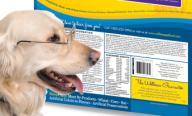A poll commissioned by the Wellness(R) brand of natural pet food finds
few understand the ingredients on pet food labels.
For our pets to be as healthy as they can be, remember; just like people, they are what they eat. Wellness(R) Natural Pet Food says pick up the bag and read the ingredient label. With Wellness you’ll see lean meats like deboned chicken, whole grains, and a rainbow of fruits and vegetables such as carrots, sweet potatoes, apples and blueberries; not chemicals or fillers like wheat, wheat gluten or soy or artificial colors and preservatives.
 TEWKSBURY, Mass., Oct. 7 /PRNewswire/ — A new poll released today shows most people don’t know what ingredients are in their pets’ food, and when pressed, show they are ultimately not feeding the ingredients they think they are.
TEWKSBURY, Mass., Oct. 7 /PRNewswire/ — A new poll released today shows most people don’t know what ingredients are in their pets’ food, and when pressed, show they are ultimately not feeding the ingredients they think they are.
Of 1,305 U.S. adult dog and/or cat owners, two-thirds say they feed their dog(s)/cat(s) as if they are members of the family. But their actions don’t always support the claim. 56 percent say they always read the label on their own packaged foods (e.g. pasta, pre-packaged or frozen meals), but only 20 percent of dog owners and 19 percent of cat owners say they always read the labels on their pets’ food. Just 38 percent say they understand all the ingredients listed on their dog/cat food labels.
The new survey was conducted in August by Harris Interactive(R) and commissioned by the Wellness(R) brand of natural food and treats for pets.
No doubt Americans love their pets – 85 percent of dog and/or cat owners agree that the health of their dogs and cats is as important to them as the health of their family. But the survey shows a disconnect between what pet parents think should or should not be in their dog/cat food, and what
really is.
For instance, 91 percent of dog and cat owners said they would not want their pets’ food to contain ingredients that cause allergies or food intolerance. Another 66 percent said their preference would be to only feed natural pet food. In reality though, most consumers are buying pet food that is not natural, and that include some of the ingredients they don’t want.
“We know that with pets, as with people, you are what you eat, which is why it is so important to understand the ingredients we’re feeding our cats and dogs,” said Wellness President Michael Meyer. “We’ve made it our mission to educate dog and cat parents as to what makes a quality ingredient and to empower them to know what they are feeding their beloved animals. That way they can be confident they truly are meeting their mission of feeding their pets as high quality a food as they would the rest of their family.”
Additional findings of the survey included:
- 56 percent worry their dog(s)/cat(s) food contains ingredients they wouldn’t want him/her consuming.
- More than half of dog and/or cat owners (55%) don’t know what federal body is charged with regulating pet food quality
- When asked to name the first ingredient listed on the label of their cat(s)’ dry food, 48 percent of cat owners answered they are not sure
- When asked to name the first ingredient listed on the label of their dog(s)’ dry food, 44 percent of dog owners answered they are not sure
So what should pet parents who want to feed the best and trust their ingredients do?
The pet nutrition experts at Wellness recommend consumers pick up the bag, turn it over and study the ingredient label. They should look for:
- Real meat should be the first ingredient, not meat or poultry by-products
- Avoid commonly identified allergens (e.g. wheat, wheat gluten, soy)
- No artificial flavors, colors or preservatives should be found in the food
- Look for ingredients you do recognize, like de-boned chicken, whole fish and wholesome fruits and vegetables
All Wellness food and treat recipes for dogs and cats are made using human-quality ingredients without the use of meat by-products, fillers, potential allergens such as wheat (including wheat gluten), artificial colors, flavors or preservatives.

About the Consumer Survey
The Pet Food survey was conducted online by Harris Interactive on behalf of Wellness between August 11 and August 13, 2008 among 2,151 adults ages 18+, of whom, 1,305 are dog and/or cat owners, 906 are dog owners and 783 are cat owners. Data were weighted to be representative of the U.S. adult population. For complete survey methodology, including weighting variables, please contact Erin Vadala or Allyson Reckerman.
About Wellness(R) – Unconditional Love. Uncompromising Nutrition.(R)
The Wellness brand of Natural Food and Treats for Pets, a proud member of the Old Mother Hubbard pet food family, was founded on the belief that, “You are what you eat!” – and that incorporating a holistic approach to a healthy, nutritious diet is the foundation of wellbeing. Our committed team
of vets, nutritionists, and animal lovers has spent decades creating the very best in all-natural nutrition for both dogs and cats. All Wellness food and treat varieties feature recipes using human-quality ingredients without the use of meat by-products, fillers, potential allergens such as wheat (including wheat gluten), artificial colors, flavors or preservatives. Wellness is sold through knowledgeable pet specialty stores and natural food stores in North America, and is now available
internationally. For more information visit www.wellnesspetfood.com.
About Harris Interactive
Harris Interactive is a global leader in custom market research. With a long and rich history in multimodal research that is powered by our science and technology, we assist clients in achieving business results. Harris Interactive serves clients globally through our North American, European and Asian offices and a network of independent market research firms. For more information, please visit www.harrisinteractive.com.




2 Comments
Wellness is one of the best pet foods out there. Yes, people really need to read those labels and watch out for terms like “byproducts, meal, and unspecified animal fat.” Many bad things lurk in these mystery ingredients that are causing dogs and cats diseases. Thanks for posting about this important topic for our pets.
You have to check the ingredients when buying pet food, or you don’t have any idea what they’re eating. Some foods have more fillers than others, and fewer substantive ingredients.